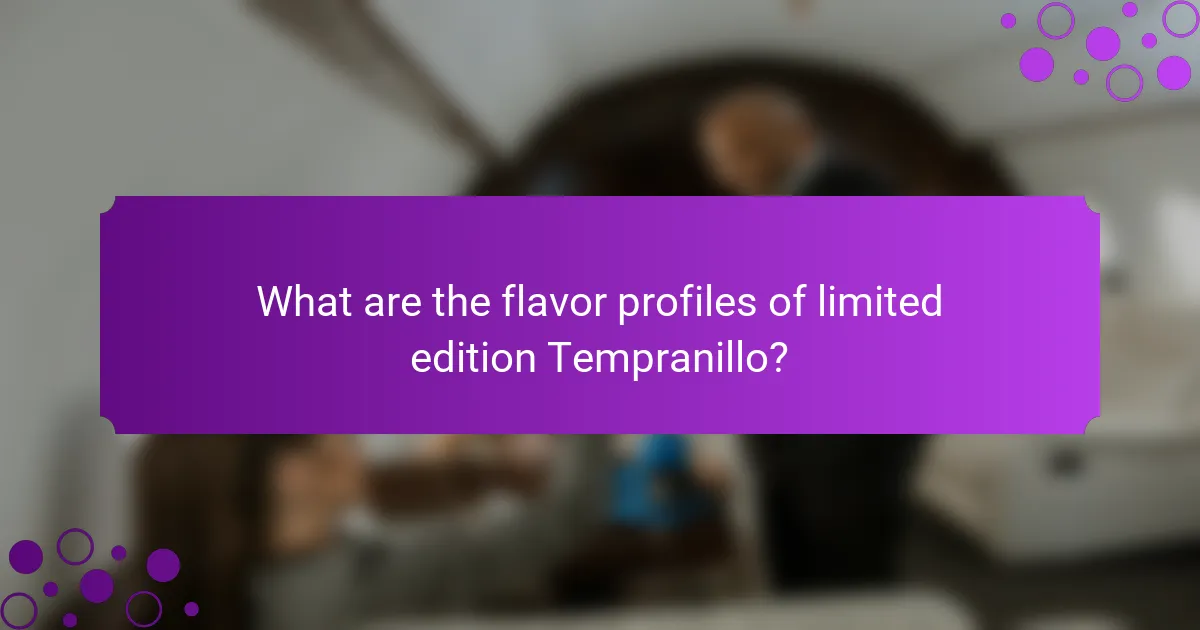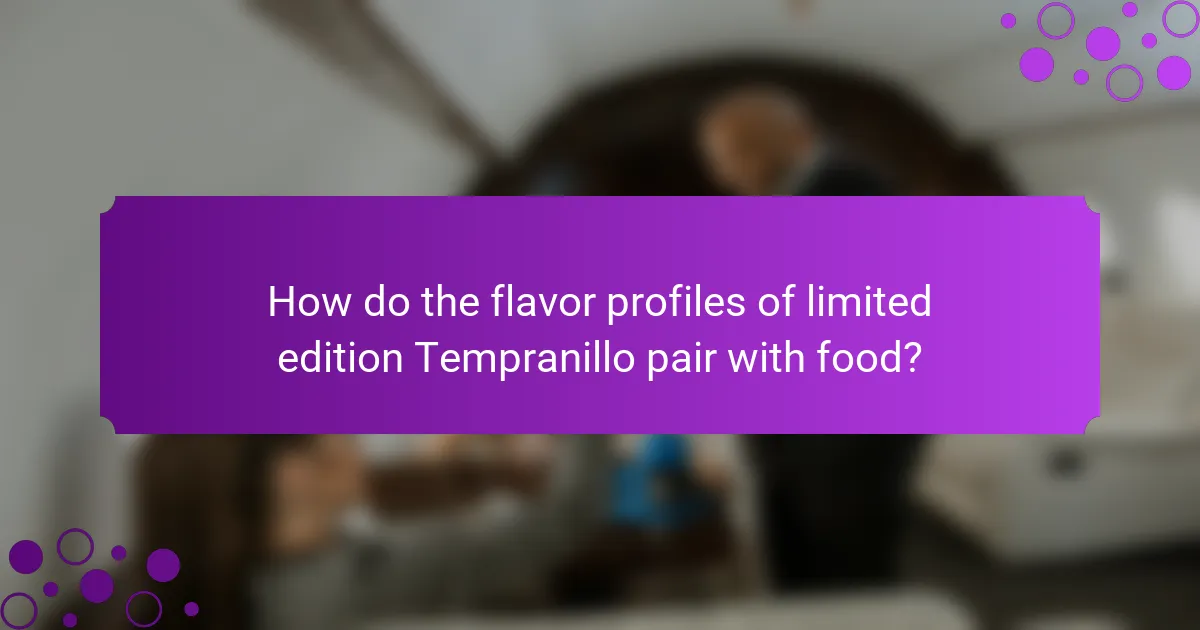
What are the flavor profiles of limited edition Tempranillo?
Limited edition Tempranillo typically exhibits rich and complex flavor profiles. These wines often feature dark fruit notes, such as blackberry and plum. Oak aging introduces additional flavors like vanilla, spice, and toasted wood. Some limited editions may also show earthy undertones, including leather and tobacco. The balance of acidity and tannins enhances the overall mouthfeel. These characteristics make limited edition Tempranillo versatile for food pairings. Common pairings include grilled meats, rich sauces, and aged cheeses. The unique attributes of each limited edition can vary based on the region and winemaking techniques.
How does oak aging influence the flavor profiles of Tempranillo?
Oak aging enhances the flavor profiles of Tempranillo by imparting complex aromas and tastes. It introduces notes of vanilla, spice, and toast, which complement the wine’s inherent fruit flavors. The interaction between the wine and oak barrels allows for the extraction of tannins, adding structure and depth. This aging process can soften the wine’s acidity and enhance its mouthfeel. Research indicates that American oak tends to impart stronger coconut and vanilla flavors, while French oak contributes more subtle spice and floral notes. The duration of aging also affects flavor; longer aging can lead to more pronounced oak characteristics. Overall, oak aging significantly enriches the sensory experience of Tempranillo.
What specific flavors are imparted by oak aging in Tempranillo?
Oak aging in Tempranillo imparts flavors of vanilla, spice, and toast. These flavors result from the interaction between the wine and the wood during the aging process. Vanilla notes come from the lactones in the oak. Spicy characteristics often include clove and cinnamon. Toasted oak adds a smoky quality to the wine. The duration of aging influences the intensity of these flavors. Typically, longer aging periods enhance the complexity and depth of the flavor profile. Studies show that oak aging significantly alters the sensory attributes of Tempranillo, making it more robust and layered.
How does the duration of oak aging affect the taste of Tempranillo?
The duration of oak aging significantly influences the taste of Tempranillo. Longer oak aging typically enhances flavors of vanilla, spice, and toast. These flavors emerge from the interaction between the wine and the wood. Shorter aging periods may result in more pronounced fruit characteristics. The balance between fruit and oak flavors is crucial. Studies show that aging for 12 to 24 months can create a harmonious blend. Aging beyond 24 months may lead to more complex flavors, but risks overshadowing the fruit. Therefore, the duration of oak aging is vital in shaping Tempranillo’s overall flavor profile.
What is the fruit complexity found in limited edition Tempranillo?
Limited edition Tempranillo typically exhibits a rich fruit complexity. This complexity often includes notes of dark berries, such as blackberry and plum. Additionally, it may feature hints of cherry and raspberry. The aging process can enhance these fruit characteristics. Oak aging introduces layers of vanilla and spice. This combination creates a well-rounded flavor profile. The fruit complexity is a defining trait of high-quality Tempranillo. These flavors contribute to the overall depth and enjoyment of the wine.
Which fruit flavors are commonly present in Tempranillo?
Tempranillo commonly features fruit flavors such as cherry, plum, and blackberry. These flavors contribute to its rich and complex profile. Cherry notes often provide a bright acidity. Plum flavors add depth and sweetness. Blackberry enhances the wine’s dark fruit character. Other fruit flavors may include raspberry and fig. The variation in fruit flavors can be influenced by the region and winemaking techniques. These characteristics make Tempranillo versatile for food pairings.
How do different growing regions affect the fruit complexity of Tempranillo?
Different growing regions significantly influence the fruit complexity of Tempranillo. Regions like Rioja produce wines with rich cherry and plum flavors. In contrast, regions such as Ribera del Duero yield more intense dark fruit notes and earthy undertones. Climate and soil composition are crucial factors. Warmer climates often enhance ripeness, leading to bolder fruit characteristics. Cooler regions may retain acidity, resulting in a more balanced profile. The altitude also plays a role; higher elevations can produce fresher, more vibrant fruit flavors. Terroir, including local winemaking practices, further shapes the final flavor profile. Thus, the interplay of these regional factors creates distinct expressions of Tempranillo.
What are the key characteristics that define limited edition Tempranillo?
Limited edition Tempranillo is characterized by its unique flavor profile, limited production, and distinct aging process. This wine often exhibits enhanced complexity due to careful vineyard selection and harvest timing. It typically features rich fruit flavors, such as blackberry and plum, alongside earthy undertones.
The aging process in high-quality oak barrels contributes to a smooth texture and adds notes of vanilla and spice. Limited editions may also showcase unique terroirs, providing distinct mineral qualities. The production is often small-scale, ensuring meticulous attention to detail.
These wines usually have higher tannin levels, which allows for greater aging potential. Limited edition Tempranillo is often crafted to highlight the winemaker’s vision and artistic expression, making each release unique.
How does vintage impact the flavor profile of Tempranillo?
The vintage of Tempranillo significantly influences its flavor profile. Different vintages experience varying weather conditions, which affect grape ripeness. Warmer vintages typically produce riper fruit flavors, such as blackberry and plum. Cooler vintages tend to yield more acidity and herbal notes, like green pepper or mint.
Additionally, the aging process can vary with vintage. Older vintages may develop more complex secondary flavors, such as leather, tobacco, and earthiness. In contrast, younger vintages often showcase fresher fruit characteristics.
Research indicates that vintage variation is crucial in determining wine quality and flavor complexity. A study from the Journal of Wine Research highlights how climatic factors directly impact grape composition and, consequently, the resulting wine’s flavor profile.
What role do winemaking techniques play in shaping Tempranillo’s flavors?
Winemaking techniques significantly influence Tempranillo’s flavors. Techniques such as fermentation temperature control enhance fruitiness. Extended maceration can increase tannin extraction, leading to a fuller body. Oak aging introduces vanilla, spice, and toasted notes. The choice of oak type affects flavor complexity. For example, American oak imparts distinct coconut flavors, while French oak adds subtle spice. Additionally, malolactic fermentation softens acidity, creating a smoother mouthfeel. These techniques collectively shape the overall flavor profile of Tempranillo, making it versatile for various pairings.

How do the flavor profiles of limited edition Tempranillo pair with food?
Limited edition Tempranillo features complex flavor profiles that pair well with various foods. These wines often exhibit rich fruit notes, such as cherry and plum, alongside earthy undertones. The oak aging process adds vanilla and spice characteristics, enhancing food compatibility. Tempranillo’s acidity and tannins balance well with grilled meats, such as lamb or beef. Its fruitiness complements dishes like mushroom risotto or roasted vegetables. Additionally, the wine’s depth pairs nicely with aged cheeses. Overall, the nuanced flavors of limited edition Tempranillo create versatile pairing options across a range of cuisines.
What are the best food pairings for limited edition Tempranillo?
The best food pairings for limited edition Tempranillo include grilled meats, rich stews, and aged cheeses. Grilled lamb chops complement the wine’s bold flavors. Beef stew enhances the wine’s fruit complexity. Aged Manchego cheese balances the wine’s acidity. Additionally, mushroom risotto pairs well due to its earthy notes. These pairings enhance the overall tasting experience of limited edition Tempranillo.
How do different flavor profiles of Tempranillo influence food pairing choices?
Different flavor profiles of Tempranillo significantly influence food pairing choices. Tempranillo can exhibit fruit-forward characteristics, earthy notes, or oak influences. Fruity profiles, often featuring cherry and plum, pair well with grilled meats and tomato-based dishes. Earthy notes, such as leather and tobacco, complement rich, savory foods like lamb and mushroom risotto. Oak aging introduces vanilla and spice, making it suitable for barbecued dishes and aged cheeses. The balance of acidity and tannins in Tempranillo enhances its versatility with various cuisines. This adaptability allows for pairings ranging from Spanish tapas to hearty stews.
What types of cuisine complement the flavors of Tempranillo?
Spanish cuisine complements the flavors of Tempranillo. Dishes such as paella enhance its fruity and earthy notes. Charcuterie, especially cured meats, pairs well due to the wine’s acidity. Grilled vegetables also match Tempranillo’s profile, highlighting its herbal undertones. Rich stews, particularly those with lamb or beef, benefit from the wine’s tannins. Additionally, tapas featuring olives and cheeses create a harmonious balance with its flavor complexity. These cuisines bring out the best characteristics of Tempranillo.
Why is understanding food pairing important for enjoying Tempranillo?
Understanding food pairing is important for enjoying Tempranillo because it enhances the wine’s flavor profile. Tempranillo has rich fruit flavors and earthy notes. Pairing it with complementary foods can amplify these characteristics. For example, grilled meats and aged cheeses bring out the wine’s complexity. The right food can balance the wine’s acidity and tannins. Studies show that food and wine pairing can significantly improve the overall tasting experience. Proper pairings create a harmonious balance, making each component more enjoyable.
What are the benefits of pairing limited edition Tempranillo with specific dishes?
Pairing limited edition Tempranillo with specific dishes enhances the overall dining experience. The wine’s complex flavor profile complements various foods. For example, its oak aging adds depth that pairs well with grilled meats. The fruit complexity of Tempranillo balances rich sauces and fatty dishes. This pairing can elevate the wine’s fruit notes, highlighting berry flavors. Additionally, the tannins in Tempranillo soften when matched with protein-rich foods. This interaction can lead to a smoother mouthfeel. Research shows that proper pairings can enhance taste perception, making each component more enjoyable.
How can food pairing enhance the tasting experience of Tempranillo?
Food pairing enhances the tasting experience of Tempranillo by complementing its flavor profile. Tempranillo typically exhibits notes of cherry, plum, and leather. Pairing it with grilled meats enhances the wine’s fruitiness and tannic structure. Rich, fatty foods like lamb or beef can balance its acidity. Additionally, aged cheeses can highlight the wine’s complexity. Studies show that food can influence the perception of wine flavors. For example, savory dishes can amplify the wine’s earthy notes. This synergy creates a more enjoyable tasting experience overall.

What practical tips can enhance your experience with limited edition Tempranillo?
To enhance your experience with limited edition Tempranillo, consider proper glassware. Use a large, tulip-shaped glass to allow aromas to concentrate. Serve it at the right temperature, ideally between 60-65°F. This temperature range highlights the wine’s fruit complexity. Decanting the wine can also improve its flavor profile. Allow it to breathe for at least 30 minutes before tasting. Pair the wine with complementary foods, such as grilled meats or aged cheeses. This pairing enhances the wine’s oak aging effects. Lastly, take notes of your tasting experience. Documenting flavors and aromas can deepen your appreciation for limited edition Tempranillo.
How should limited edition Tempranillo be served for optimal flavor?
Limited edition Tempranillo should be served at a temperature between 60°F to 65°F. This range enhances its complex flavors and aromas. Serving it too cold can mute the wine’s characteristics. Using a large, tulip-shaped glass allows for better aeration. Aeration helps release the wine’s bouquet and flavors. Decanting for at least 30 minutes prior to serving is recommended. This process softens tannins and enhances the overall tasting experience. Pairing with rich foods like grilled meats or aged cheeses complements its profile. These serving methods optimize the flavor profile of limited edition Tempranillo.
What is the ideal temperature for serving Tempranillo?
The ideal temperature for serving Tempranillo is between 60°F and 65°F (15°C to 18°C). This temperature range allows the wine’s flavors and aromas to fully develop. Serving Tempranillo too cold can mute its complex fruit notes. Conversely, serving it too warm can enhance alcohol perception. Many experts recommend slightly chilling the wine before serving. This practice helps balance the wine’s structure and acidity. Research indicates that proper serving temperature enhances the overall tasting experience.
How should you decant limited edition Tempranillo for best results?
To decant limited edition Tempranillo for best results, pour it gently into a decanter. This process allows the wine to aerate and enhances its flavors. Aim to decant at least 30 minutes before serving. For optimal results, use a clean glass decanter to avoid contamination. The aeration process helps to soften tannins and release aromatic compounds. Limited edition Tempranillo often has complex flavor profiles that benefit from this exposure to air. Studies show that proper decanting can significantly improve the tasting experience by revealing the wine’s full character.
What common mistakes should be avoided when tasting limited edition Tempranillo?
Common mistakes to avoid when tasting limited edition Tempranillo include not allowing the wine to breathe. Allowing oxygen to interact with the wine enhances its flavors. Another mistake is neglecting to assess the wine’s appearance. Noting color and clarity can indicate quality and age. Failing to swirl the wine is also a common error. Swirling releases aromatic compounds, enriching the tasting experience. Additionally, overlooking the aroma is a mistake. The nose significantly contributes to overall flavor perception. Tasting too quickly without savoring each sip can lead to missing nuances. Finally, pairing the wine with incongruent foods may detract from its characteristics. Understanding flavor profiles enhances the tasting experience.
How can improper serving affect the flavor of Tempranillo?
Improper serving can significantly alter the flavor of Tempranillo. Serving temperature plays a crucial role in flavor perception. If served too cold, the wine’s aromas and flavors can be muted. This results in a less expressive tasting experience. Conversely, serving it too warm can enhance alcohol perception. This can overshadow the wine’s fruit and tannin balance. Additionally, improper glassware can affect aeration. A narrow glass may restrict aroma release. This limits the drinker’s ability to fully appreciate the wine’s complexity. Proper serving enhances the overall enjoyment and flavor profile of Tempranillo.
What are the signs of a poorly stored limited edition Tempranillo?
Signs of a poorly stored limited edition Tempranillo include off-putting odors, such as vinegar or mustiness. These odors indicate potential spoilage due to improper temperature or humidity. Additionally, the wine may show signs of oxidation, evidenced by a brownish hue and a flat taste. A cork that is pushed out or leaking suggests excessive pressure or spoilage. Cloudiness or sediment that is not typical for the wine also indicates spoilage. Finally, a lack of fruit aroma or flavor can signify that the wine has deteriorated. Proper storage conditions are essential to maintain the quality of limited edition Tempranillo.
Limited edition Tempranillo is characterized by its rich and complex flavor profiles, often featuring dark fruit notes, oak aging influences, and unique terroir characteristics. The article explores how oak aging enhances flavors such as vanilla and spice, while also discussing the impact of fruit complexity from different growing regions. Additionally, it provides insights into optimal food pairings that complement the wine’s attributes, enhancing the overall tasting experience. Key considerations for serving and decanting limited edition Tempranillo are also outlined to maximize flavor enjoyment.